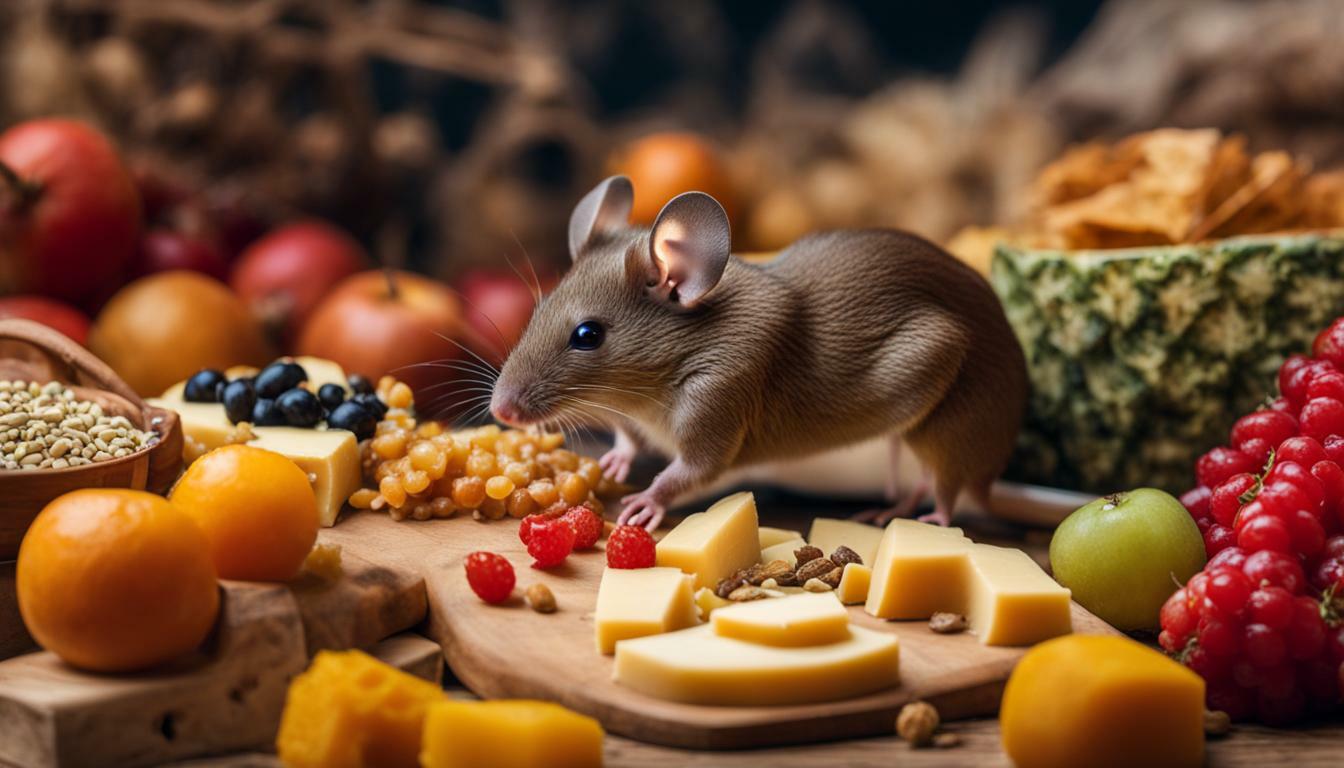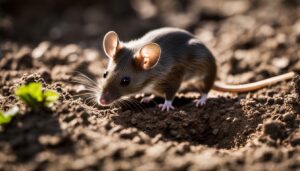Mice possess an incredible sense of smell, with around 300 million olfactory receptors, far surpassing humans’ 5 million. This keen sense of smell enables mice to detect food sources from distances as far as 1-2 miles away, depending on factors like wind direction and the intensity of the odor. Even if food is sealed in a jar, mice can still smell it if there are slight openings or peanut butter residue present on the outside. Peanut butter, with its potent aroma, is commonly used as bait in mouse traps.
Key Takeaways:
- Mice have approximately 300 million olfactory receptors, compared to humans’ 5 million.
- Mice can detect food sources from distances as far as 1-2 miles away.
- Factors such as wind direction and the intensity of the odor can affect the distance at which mice can smell food.
- Mice can still smell food even if it is sealed in a jar, through slight openings or peanut butter residue.
- Peanut butter is commonly used as bait in mouse traps due to its strong scent.
Factors Affecting Mice’s Sense of Smell
The ability of mice to detect food is influenced by various factors, such as wind direction and the intensity of the odor. Mice have an impressive sense of smell, with around 300 million olfactory receptors compared to humans’ 5 million. This heightened sense of smell allows them to detect food sources even from distances as far as 1-2 miles away.
One key factor that affects the ability of mice to smell food is wind direction. When the wind carries the odor molecules of food in the direction of mice, it enhances their chances of detecting it. However, if the wind is blowing in the opposite direction, it can decrease the range at which mice can smell the food.
The intensity of the odor emitted by the food source also plays a vital role. Mice are more likely to detect strongly scented foods from a greater distance. The more potent the smell, the more likely mice are to be attracted to the source.
| Factors Affecting Mice’s Sense of Smell |
|---|
| Wind direction |
| Intensity of odor |
If necessary and relevant:
Although wind direction and odor intensity are the primary factors that impact mice’s ability to detect food, other variables may also come into play. Factors such as the weather conditions, humidity levels, and the presence of other strong odors in the surroundings can affect the range at which mice can smell food.
Understanding these factors is crucial when it comes to implementing effective mouse control strategies. By taking into account wind direction and using bait with strong odors, such as peanut butter, you can increase the chances of attracting mice to traps and bait stations. Additionally, sealing exterior openings and using rodent-proof materials can help prevent mice from accessing food sources in the first place.
To summarize, mice possess an exceptional sense of smell, allowing them to detect food from impressive distances. Factors like wind direction and the intensity of the odor influence their ability to smell food. By considering these factors and implementing proactive measures, you can effectively control and prevent mouse infestations in your home or business.
Detecting Food in Sealed Containers
Even if food is sealed in a jar, mice can still detect its presence through slight openings or the lingering aroma of peanut butter residue. Mice possess a remarkable sense of smell, with approximately 300 million olfactory receptors compared to humans’ mere 5 million. This heightened sense allows them to sniff out food sources from impressive distances, making it crucial to ensure that containers are tightly sealed to prevent any unwanted scents from escaping.
In their relentless quest for a meal, mice can detect even the tiniest openings in containers. If there are slight gaps or spaces where air can enter, these crafty creatures can pick up on the scent and make their way to the food inside. Additionally, the lingering aroma of peanut butter residue on the outside of a sealed jar can act as an irresistible beacon, drawing mice closer and encouraging them to investigate further.
To protect your food from these sneaky scavengers, it’s essential to conduct a thorough inspection of all containers. Check for any gaps or holes that may have formed, ensuring that the lids are tightly sealed to prevent any escape of odor. It’s also advisable to wipe down the outside of containers regularly to remove any peanut butter residue, as even the smallest traces can be enough to attract mice.
| Preventive Measures: |
|---|
| 1. Check containers for any openings or gaps that mice could exploit. |
| 2. Ensure that lids are tightly sealed to prevent the escape of food odor. |
| 3. Regularly wipe down containers to remove any peanut butter residue. |
By taking these preventive measures, you can minimize the chances of mice detecting and accessing your sealed food containers. Be vigilant in your efforts and eliminate any potential entry points to keep these unwanted guests at bay.
The Use of Peanut Butter as Bait
Peanut butter is a popular choice for bait in mouse traps due to its potent aroma that attracts mice. Mice have a very keen sense of smell, with around 300 million olfactory receptors compared to humans’ 5 million. They can detect food sources from distances as far as 1-2 miles away, depending on factors like wind direction and the intensity of the odor. Even if food is sealed in a jar, mice can still smell it if there are slight openings or the peanut butter residue is present on the outside.
When using peanut butter as bait, it is important to place the trap in hidden areas where mouse activity is observed and use a small amount of peanut butter. Mice can enter through openings as small as 1/4″ in diameter and can reproduce up to 8 litters per year with 4-7 pups per litter. Garbage, fallen fruits and nuts, bird seed, and pet food left out overnight are some food sources that attract mice.
To keep mice away, it is important to seal all exterior openings greater than 1/4″ in size and use materials that are rodent-proof. Trapping is an effective means of controlling mice, and bait stations can be made using plastic containers and properly secured. Stay Away® Rodent Repellent, made with essential oils and botanical ingredients, can also be used to repel mice from certain areas.
| Key Points: |
|---|
| Peanut butter is a popular choice for bait in mouse traps due to its potent aroma. |
| Mice have a keen sense of smell and can detect food from far distances. |
| Even if food is sealed in a jar, mice can still smell it through slight openings or peanut butter residue. |
| When using peanut butter as bait, place traps in hidden areas with mouse activity and use a small amount of bait. |
| Seal all exterior openings and use rodent-proof materials to prevent mouse infestations. |
| Trapping and using bait stations made from plastic containers are effective mouse control methods. |
| Stay Away® Rodent Repellent, made with essential oils and botanical ingredients, can be used to repel mice. |
Preventing Mouse Infestations
To keep mice away, it is crucial to seal all exterior openings larger than 1/4″ and utilize materials that mice cannot easily penetrate. These small rodents can squeeze through tiny openings, so it’s important to thoroughly inspect your home for any potential entry points. Common areas to check include gaps around windows and doors, cracks in the foundation, and openings where utility lines enter your house.
An effective way to seal these openings is by using rodent-proof materials such as steel wool or metal mesh. These materials are difficult for mice to gnaw through, creating a barrier that prevents them from entering your home. It’s essential to ensure that the materials are tightly packed and securely fastened to eliminate any gaps that mice could exploit.
Common Mouse Entry Points
| Location | Potential Entry Points |
|---|---|
| Windows | Cracks, gaps around frames |
| Doors | Underneath, gaps around edges |
| Foundation | Cracks, gaps, vents |
| Siding | Loose or damaged panels |
| Utility Lines | Openings where cables, pipes, or wires enter |
In addition to sealing exterior openings, it’s important to eliminate potential food sources that might attract mice. Garbage, fallen fruits and nuts, bird seed, and pet food left out overnight are all enticing to these pests. Make sure to store food in airtight containers and promptly clean up any spills or crumbs to reduce their food supply.
By taking proactive measures to prevent mouse infestations, you can protect your home from these unwanted guests. Remember to seal all exterior openings larger than 1/4″, use rodent-proof materials, and eliminate food sources that attract mice. With these steps, you can create a less inviting environment for mice and maintain a pest-free home.
Effective Mouse Control Methods
Trapping and the use of bait stations are highly effective ways to control mouse populations, while Stay Away® Rodent Repellent provides a natural repellent option. Mice have a remarkable sense of smell, making them easily attracted to food sources. By strategically placing traps in areas where mouse activity is observed, you can effectively capture mice and prevent further infestations.
When using traps, it is important to choose the right bait. Peanut butter is a popular choice due to its strong aroma, which mice find irresistible. Apply a small amount of peanut butter on the trigger of the trap to ensure mice are caught efficiently. Remember to place the traps in hidden areas or along walls, as mice tend to follow along edges.
In addition to trapping, the use of bait stations can also help control mouse populations. These stations are designed to securely hold bait and prevent access to pets or children. You can easily create your own bait station using plastic containers with small entry holes for mice. Make sure to secure the lids tightly to prevent accidental opening. Place the bait stations in areas where mouse activity is high, focusing on entry points and areas where food sources are present.
| Bait Station Tips |
|---|
| Place bait stations along walls and in corners, where mice tend to travel. |
| Use multiple bait stations to increase the likelihood of capturing mice. |
| Inspect and refill bait stations regularly to ensure effectiveness. |
| Keep bait stations out of reach of children and pets. |
If you prefer a natural approach to mouse control, consider using Stay Away® Rodent Repellent. Made with essential oils and botanical ingredients, this repellent emits a scent that mice find unpleasant, deterring them from entering or remaining in treated areas. Simply place the repellent pouches or granules in areas where mice are likely to frequent, such as entry points, nesting sites, or areas with visible droppings.
By combining trapping, the use of bait stations, and natural repellents like Stay Away® Rodent Repellent, you can effectively control mouse populations and protect your home from these unwanted guests.
Conclusion
Understanding the impressive olfactory capabilities of mice is essential in preventing infestations and implementing effective control measures. With approximately 300 million olfactory receptors, mice have a keen sense of smell that far surpasses our own 5 million. This exceptional ability allows them to detect food sources from as far as 1-2 miles away, depending on factors like wind direction and odor intensity.
Even if food is sealed in a jar, mice can still smell it if there are slight openings or peanut butter residue present. This is why peanut butter is commonly used as bait in mouse traps. Its potent aroma is simply irresistible to these curious creatures. When using peanut butter as bait, it is important to place the trap in hidden areas where mouse activity is observed and use a small amount of peanut butter to increase the chances of success.
Mice can enter through openings as small as 1/4″ in diameter and reproduce rapidly, with up to 8 litters per year and 4-7 pups per litter. To avoid attracting these unwelcome guests, it is crucial to seal all exterior openings larger than 1/4″ and choose rodent-proof materials for construction. Garbage, fallen fruits and nuts, bird seed, and pet food left out overnight are common food sources that can draw mice into your space.
In terms of control, trapping is an effective method for managing mice populations. Simple bait stations can be made using plastic containers that are properly secured. Additionally, Stay Away® Rodent Repellent, made with essential oils and botanical ingredients, can be used to naturally repel mice from certain areas. By implementing these measures and staying proactive, you can maintain a mouse-free environment and protect your property from potential damage.
FAQ
How far can mice smell food?
Mice have a remarkable sense of smell and can detect food sources from distances as far as 1-2 miles away, depending on factors like wind direction and the intensity of the odor.
What factors can affect mice’s sense of smell?
Factors such as wind direction and the intensity of the odor emitted by the food source can influence the distance at which mice can smell food.
Can mice detect food in sealed containers?
Yes, mice can still smell food in sealed containers if there are slight openings or if peanut butter residue is present on the outside.
Why is peanut butter commonly used as bait in mouse traps?
Peanut butter is used as bait in mouse traps because of its potent aroma, which mice find irresistible.
How can I prevent mouse infestations?
To prevent mouse infestations, it is important to seal all exterior openings greater than 1/4″ in size and use materials that are rodent-proof. Additionally, avoid leaving out garbage, fallen fruits and nuts, bird seed, or pet food overnight as these can attract mice.
What are effective methods for controlling mice?
Trapping is an effective means of controlling mice. You can make bait stations using plastic containers and properly secure them. Stay Away® Rodent Repellent, made with essential oils and botanical ingredients, can also be used to repel mice from certain areas.




